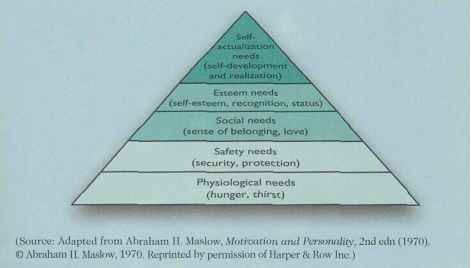Perception
A motivated person is ready to act. How the person acts is influenced by his or her perception of the situation. Two people with the same motivation and in the same

- Figure 6.4
Maslow's hierarchy of needs situation may act quite differently because they perceive the situation differently. Anna Flores might consider a fast-talking camera salesperson loud and false. Another camera buyer might consider the same salesperson intelligent and helpful.
Why do people perceive the same situation differently? All of us learn by the flow of information through our five senses: sight, hearing, smell, touch and taste. However, each of us receives, organizes and interprets this sensory information in an individual way. Thus perception is the process by which people select, organize and interpret information to form a meaningful picture of the world.
People can form different perceptions of the same stimulus because of three perceptual processes: selective attention, selective distortion and selective retention.
SELECTIVE ATTENTION. People are exposed to a great number of stimuli every day. For example, the average person may be exposed to more than 1,500 ads a day. It is impossible for a person to pay attention to all these stimuli and some studies show people remembering only three or four.23 Selective attention -the tendency for people to screen out most of the information to which they are exposed - means that marketers have to work especially hard to attract the consumer's attention. Their message will be lost on most people who are not in the market for the product. Moreover, even people who are in the market may not notice the message unless it stands out from the surrounding sea of other ads.
SELECTIVE DISTORTION. Even noted stimuli do not always come across in the intended way. Each person fits incoming information into an existing mindset. Selective distortion describes the tendency of people to adapt information to personal meanings. Anna Flores may hear the salesperson mention some good anil bad points about a competing camera brand. Because she already has a strong leaning towards Nikon, Olympus or Polaroid, she is likely to distort those points in order to conclude that one camera is better than the others. People tend to interpret information in a way that will support what they already believe. Selective distortion means that marketers must try to understand the mind-sets of consumers and how these will affect interpretations of advertising and sales information:

selective attention
The tendency of people to screen out most of the information to which they are exposed.
perception
The proeeKS by which people select, organise and interpret informntiun to form a meaningful pic tun of the world.
selective distortion The tendency of people to adapt information to personal meanings.
Selected attention-, the average person is expound to more than 1500 ads per day -in magazines and newspapers, on radio and TV, and ail around them.
selective retention The tendency of people to retain only part of the information to -which they are exposed, usually information that supports their attitudes or beliefs.
learning Changes in an individual's behaviour arising from experience.
Cathay Pacific, the Hong Kong-based airline, found out that although Caucasians saw Cathay as an Asian airline, Asians perceived the airline as being well managed and safe, but not Asian. Seeing their future in Asia where 80 per cent of their passengers came from, Cathay wants to change their view. Peter Sutch, Cathay's chairman, explains their new livery: 'We wanted something Asian in appearance: we wanted a quality look with an Asian flavour.' The airline now offers a wide range of Asian meals and communicates in many Asian languages. In-flight information is now in Japanese, Korean, Mandarin and Cantonese as well as English.2<>
SELECTIVE RETENTION. People will also forget much of what they learn. They tend to retain information that supports their attitudes and beliefs. Because of selective retention, Anna is likely to remember good points made about the Nikon and forget good points made about competing cameras. She may remember Nikon's good points because she 'rehearses' them more whenever she thinks about choosing a camera.
Because of selective exposure, distortion and retention, marketers have to work hard to get their messages through. This fact explains why marketers use so much drama and repetition in sending messages to their market. Although some consumers are worried that they will be affected by marketing messages without even knowing it, most marketers worry about whether their offers will be perceived at all.37
Continue reading here: Types of Buying Decision Behaviour
Was this article helpful?
Readers' Questions
-
Eulalia1 year ago
- Reply
